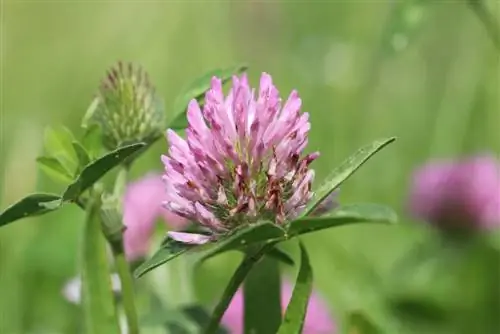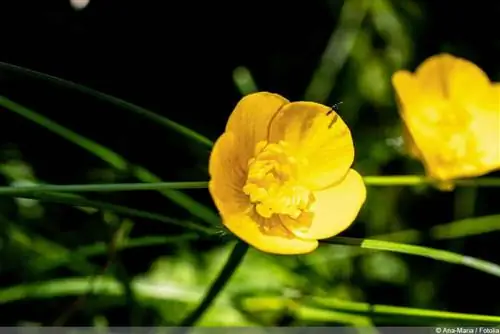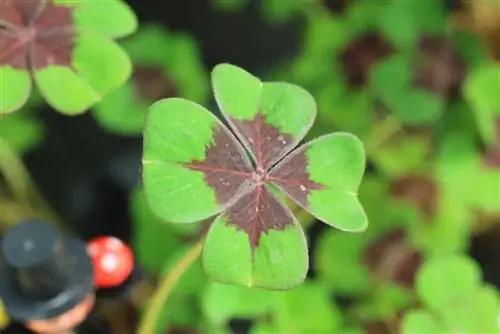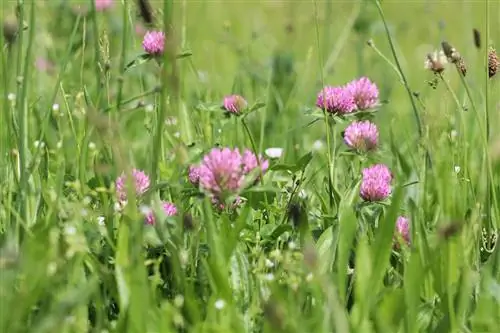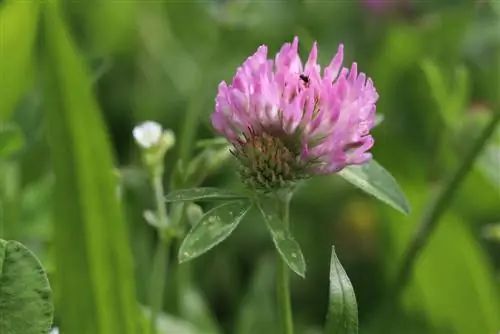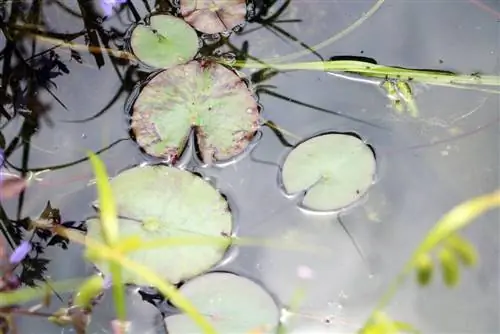- Author admin [email protected].
- Public 2023-12-17 03:39.
- Last modified 2025-01-24 12:45.
The insects love it - but for the gardener, red clover is often worse than the plague. Once it has settled in the lawn, it can only be removed with great difficulty. Its long runners creep through the grass and take away space and light until there is hardly anything left of the once beautiful lawn. Find out how you can fight red clover in your lawn in this article.
Occurrence and identifying features
Red clover, also known as meadow clover, is a plant native to us. Their natural occurrence extends from Europe to central Asia. The plant feels at home on nutrient-rich roadsides, in meadows and forest clearings. In the highlands it can be found up to 2500 meters. Trifolium pratense belongs to the clover genus (Trifolium), which contains more than 200 different species of the herbaceous plant. The perennial meadow clover can reach heights of up to 60 cm, although in its natural environment it is usually significantly smaller. On lawns that are mowed regularly, it is only just above ground level. Its leaves are arranged in groups of three (tri means three, folium leaf) at the tip of the leaf stem. The light grain in the middle of each leaf is particularly noticeable. During the flowering period between early May and mid-October, red clover produces spherical inflorescences containing up to 100 individual pink flowers. There are different varieties of red clover that are named after their main area of distribution.
- Coastal meadow clover (Trifolium pratense subsp. maritinum)
- Alpine meadow clover (Trifolium pratense subsp. nivale)
- Common meadow clover (Trifolium pratense supsp. pratense)
Red clover is one of the most beneficial plants for humans and animals, as the herbaceous plant is an important supplier of pollen for insects and a fodder plant for grazing livestock. Last but not least, red clover helps alleviate symptoms in medicine. But the plants are not welcome in every garden. Red clover quickly becomes a competitor in lawns and replaces them over time. Bare and sandy locations are particularly affected.
Causes
A lawn should, if possible, be free of weeds. This not only looks much neater, but is also a sign of he althy grass with strong roots. If clover settles in the lawn, this is a clear indication that the natural balance is disturbed. The causes of such a malfunction include:
- Soil pH value is too high
- the nutrient content in the soil is not optimal
- the lawn is not cared for adequately
Excessively high pH values mean that red clover finds ideal growth conditions. If the grasses in the lawn are weakened, the robust meadow clover can establish itself better and multiply undisturbed. It is therefore important to create optimal conditions for the lawn grasses so that they can permanently return to their old shape. Some of these measures are part of normal lawn care anyway. So they not only strengthen the lawn, but also remove the meadow clover at the same time.
Systematic approach
In contrast to white clover, which is relatively easy to remove from the lawn, red clover is much more stubborn. While the herbaceous plant with its reddish flowers is a pretty sight in natural meadows, it should not even take root in the edge areas of the lawn. Red clover is a characteristic deep-rooting plant that forms a long taproot that can reach up to two meters deep into the soil. It spreads through underground runners called rhizomes. The tricky thing is that root pieces and offshoots that remain in the soil usually sprout again after a short time. The most effective way is to systematically eliminate red clover from the lawn. A combination of different control options is recommended.
1. Manual emergency measures
Depending on how much meadow clover already runs through the lawn, the grass should be mown low and thoroughly scarified. Contiguous areas of red clover should first be cut out by hand and removed as much as possible. It is best to fill these bare spots immediately with new lawn seed from a reseeding mixture. In order for the seeds to germinate and grow well, it is important to keep these areas of the lawn well moist. The ideal time for this is spring. It is possible and also sensible to remove the meadow clover during the remaining growth period.
Verticutting
Since heavy weed growth inhibits the growth of the lawn, something urgently needs to be done about it. An efficient method of preventing heavy clover growth is scarifying. By removing thatch mechanically, you not only free the lawn from meadow clover, but also from dead blades of grass and annoying moss, so that the grass gets more air again. Scarifying also loosens the soil so that water and oxygen can reach the grass roots unhindered.
- Time: Spring
- work on the affected areas several times
- Use an electric or petrol scarifier for large areas
- Fill bare spots with lawn seeds
- water well and fertilize
Cutting out by hand
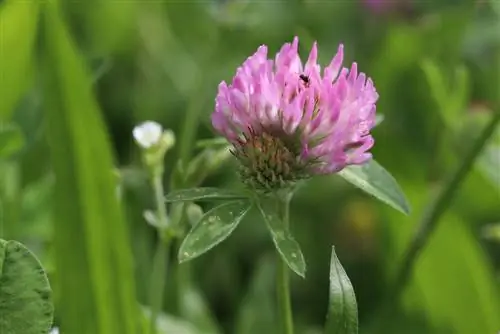
Just mowing the lawn is not an effective method of removing clover from the lawn. Manual removal of the red clover should therefore begin in spring. However, due to the high time required and physical strain, purely manual removal of red clover is only recommended for small areas. In principle, you don't need any special tools to get the red clover out of the lawn. Normally a longer kitchen knife is sufficient. If you don't want to work on your knees on the lawn, you can get a special weed cutter. These narrow miniature spades in the shape of a shoehorn are also available with a long handle. Since it is usually not possible to dig up the entire root, the procedure must be repeated regularly. To strengthen the grass, some fertilizer is then applied and new grass seeds may be sown on the bare spots.
Tip:
If a large part of the meadow clover is not removed mechanically first, all other attempts to combat red clover will be more or less ineffective. That's why a gardener can't avoid getting involved himself to permanently remove the clover from the lawn.
2. Changing soil conditions
If a large part of the unloved meadow clover has been removed, that doesn't mean that it will stay that way permanently. As long as the same conditions prevail as before, it usually comes back after a short time. In order to limit its reappearance, the conditions for the wild weed should be worsened.
Preferred location and soil conditions for red clover
The ideal location conditions for red clover are sunny to partially shaded locations and a permeable, nutrient-rich soil.
- Light requirements: sunny to partially shaded
- nutrient-rich, well-drained soil
- moderately humid
- Lime-loving
- does not like very acidic soils
- It also survives longer dry phases well thanks to its deep roots
Measures
Red clover's long taproot is one of the reasons why the herbaceous plant is so adaptable and difficult to remove from the lawn. So it is unlikely that you will be able to completely remove the clover from the garden soil by scarifying or weeding alone. That's why something has to be done for the growth of the lawn at the same time. Because in a he althy and strong lawn, clover has few chances. As a rule, the garden soil in which a lot of red clover grows in the lawn is too calcareous (pH values above 7). In addition, it does not store enough water and the nutrients are not present in the optimal amount and ratio. If the soil is made more lawn-friendly, this is a very effective measure against meadow clover. With targeted fertilization, aeration of the lawn and optimization of the pH value in the soil, you create good growth conditions for the lawn.
- Lawn prefers a pH of 6.0 on light garden soils
- on heavy soils, a pH value of 7.0 is ideal for the lawn
- Optimize soil pH
- If the soil is too calcareous, use suitable preparations to lower the pH value
- scarify in spring
- Fertilize the lawn (if there is strong red clover growth, only use special fertilizers)
- Water your lawn regularly when it is dry
- the ideal mowing height is around 4 cm
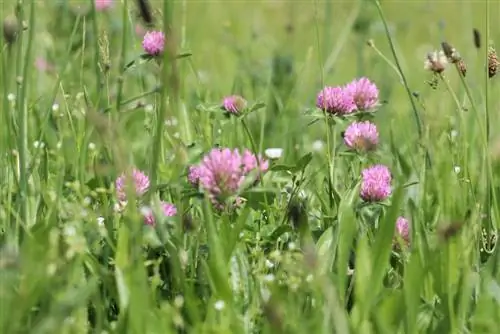
If the root thatch is removed and the dense network is cut, the grasses get more air. Ideal conditions to prevail over your competitors and form a closed turf again. Since the grass is much more sensitive to drought than meadow clover, the lawn needs to be watered frequently during longer periods without rain. Also pay attention to an optimal pH value in the soil, because this is the only way the grass can develop optimally and prevail against the meadow clover. A common mistake hobby gardeners make is liming the lawn without having determined in advance what the soil pH is. This often increases the pH value significantly. Alkaline soils (calcareous) worsen the conditions for the lawn. The red clover, however, feels really good.
Tip:
Have a soil sample checked at an appropriate institute and fertilize the lawn based on the result. You may be able to get advice from a specialist retailer.
Fertilize your lawn properly
A good lawn fertilizer ensures that the grass receives everything it needs. This is especially necessary after winter when the lawn sprouts again. Uniform growth is achieved by the nitrogen in the fertilizer. The lawn grows densely and evenly, which not only reduces the risk of burns in summer, but also helps against overgrowth of red clover. However, if you have large amounts of clover in your lawn, you should avoid using a universal fertilizer, as these often have too high a phosphate content, which in turn promotes clover growth. It is therefore recommended to use a long-term fertilizer that supplies high amounts of nitrogen, but very little to no phosphate.
- best time: just before a rainy period
- once in spring, once in summer (until the end of July at the latest)
- do not fertilize in dry soil or in full sun
- fertilize early in the morning or better yet, late afternoon
- water the lawn in advance
- The grass blades must be dried again before fertilizing
- Apply fertilizer evenly
- Quantity according to package instructions
- preferably use slow-release fertilizer
- for example horn shavings or horn meal
- There are also special lawn fertilizers with reduced phosphate content
- Lime lawns only after prior soil analysis
Tip:
So that you can find exactly the right fertilizer for your soil conditions, you should have the soil analyzed. This is the only way to dose the nutrients in a targeted manner and prevent deficiency symptoms and over-fertilization.
Sprays
Another option, although not quite as environmentally friendly, can be pesticides against red clover in the lawn. There are now a whole range of effective clover killers available that do not harm the lawn and are not dangerous to bees. These remedies are based on destroying only dicotyledonous plants such as meadow clover, but not monocots, i.e. the grasses. This leaves the lawn intact while the red clover and some other weeds disappear.
- Always use plant protection products exactly according to the instructions
- If possible, don’t mow in advance
- the product is preferably absorbed through the leaves
- use only on rain-free days
- water the lawn again the evening before (before application)
Where the red clover dies, yellow spots naturally form in the lawn. Before sowing new lawn seeds, dead plants must be removed. A light fertilization with phosphate-free fertilizer is then good for the lawn.
Tip:
When buying a lawn weed killer, pay attention to the area in which the active ingredient is used. It should be explicitly stated that it is effective against red clover or all types of clover (and not just wood sorrel). Preparations against dicotyledonous weed plants in the lawn are also suitable for combating red clover.
Radical solution
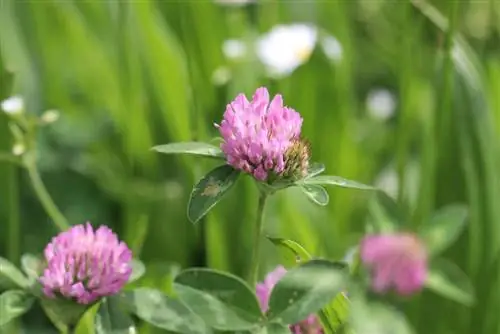
If the amount of meadow clover is excessive, the only solution may be to sow a completely new lawn. To do this, however, it is necessary to remove all roots from the soil in advance. This is the only way to ensure that no new colonization with red clover occurs. In some cases the solution lies in soil replacement.
- Time: Spring or late summer
- Remove the soil about 30 to 50 cm deep
- remove all roots and stones
- Soil through a coarse sieve several times, then pass it into a finer sieve
- prepare sifted soil with fresh humus or compost
- Apply the soil mixture back onto the area
- condense
- pour on
- sow new lawn
Make sure that all roots and plant pieces remain in the sieve, because new red clover can also grow from root pieces. If you don't want to or can't remove and replace the entire garden soil, you should try the following method:
Plastic tarpaulin against clover
A somewhat unusual but very effective and environmentally friendly method of eliminating red clover from a lawn is to cover a large area of the lawn with a plastic tarp. This is spread over the areas with heavy clover growth for a period of a few weeks. As a result of the lack of light, the red clover dies.
Of course the lawn also suffers from the conditions. However, it often recovers significantly better than clover. If the grass also dies, it's not a big deal because the lawn can easily be reseeded. However, before you sow a new lawn, the soil conditions must be improved, otherwise the red clover will come back. So don't forget to fertilize.
Conclusion
Annual scarifying, regular mowing and watering in dry times, as well as balanced fertilization are usually enough to keep red clover out of the lawn. If it has managed to establish itself, it must be removed by hand as soon as possible to prevent further spread. The conditions for the lawn should then be improved so that the grasses can better assert themselves against the wild weeds. However, meadow clover will probably never completely disappear from the lawn. That's why it's important to come to terms with the wild weeds and find a he althy middle ground.

